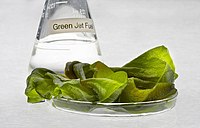
Photo from wikipedia
Abstract Hydrothermal liquefaction wastewater (HTLWW) can be used for biogas production through anaerobic digestion (AD). Nevertheless, it generally contains refractory and toxic organics which causes low methane production. The present… Click to show full abstract
Abstract Hydrothermal liquefaction wastewater (HTLWW) can be used for biogas production through anaerobic digestion (AD). Nevertheless, it generally contains refractory and toxic organics which causes low methane production. The present study showed that the methane yield and methane production rate were increased by 32–52 % and by 51–84 %, respectively, with the addition of hydrochars derived from different feedstocks including sludge, corn straw, poplar wood and Enteromorpha algae. Although hydrochars could adsorb certain amount of organics, the adsorption capacity was not related with the promotion of AD. The adsorbed organics could be neglected after AD due to the biodegradation. 3-dimensional fluorescence excitation emission matrix analysis revealed that hydrochars increased the degradation of all types of fluorescent compounds. Fourier-transform infrared spectroscopy analysis showed hydrochars significantly reduced the concentrations of aromatic, amino acids, amide I and amide II functional groups compounds in HTLWW during AD. Hydrochars also led to higher degradation of nitrogenous, aromatic and phenolic compounds as revealed by gas chromatography mass spectrometry analysis. In addition, it was shown that hydrochars resulted in low number of organic species whose concentration increased during partly degradation. Microbial analysis showed hydrochars enhanced the growth of syntrophic bacteria (e.g. Syntrophomonas and Syntrophorhabdus) which had ability to degrade an extensive range of various types of organics including aromatic and phenolic organics. Hydrochars also facilitated direct interspecies electron transfer considering the enrichment of known microbes involved in direct interspecies electron transfer (DIET) process including Geobacter and certain methanogens (Methanosaeta and Methanobacterium).
Journal Title: Chemical Engineering Journal
Year Published: 2020
Link to full text (if available)
Share on Social Media: Sign Up to like & get
recommendations!